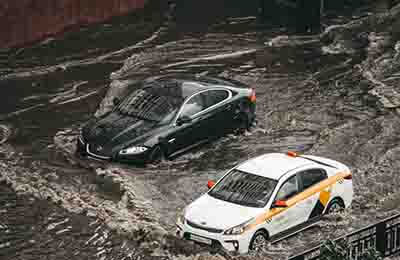洪水围困下的印度之行
时间:2022-08-11 08:50:16

刚刚过去的2010年是洪灾泛滥的一年,不单我国很多地方遭遇特大水灾,世界上许多国家也洪涝不断。本文的主人公凯莉就在印度经历了一场特大洪灾,一起来听听她讲述这段经历。
Before the Storm...
For as long as I remember, I had always wanted to travel the world. When a trip to India was advertised at school, I told myself that I would raise the money and go on it.
I managed to raise the money to pay for the trip in 18 months. When the day came round, I was so excited.
This was my dream! The team of nine students and two adults met at school and then went on our way to the airport. The flight was eight and a half hours and we all just wanted to get there to start the trip of a lifetime.
We landed in Delhi and started our travels up to the
region of Ladakh in the northwest mountainous area of
India. We were based in a town called Leh situated on the Indus River. We travelled to Leh by road, which took about a week. In the second week, we were going to
volunteer at a school―we were only supposed to stay there for six days, helping out with some construction and English
classes.
Halfway through the week, there was a huge storm. Rain came pouring through the ceiling and windows and the wind was 1)howling outside. It started at around 12:30 am,
and the first we knew about it was when our windows
2)flung open and rain came in.
The girls in the group were sharing a room and the boys were downstairs. When we heard rain 3)gushing into the building just outside our door, we ran downstairs to get the boys up to help us.
Most of us were running on 4)automatic, fetching
buckets from the shower block outside and pulling up edges
of carpets to try and 5)minimise the damage. In Ladakh, they only get about five days of rain a year, so none of the students 6)boarding at the school had a clue what to do.
Eventually the rain stopped and we could start
emptying the water out of the hallways. We lay blankets out to try and soak up the water, and some of us were up until 3 am clearing up.
The next day, it was like nothing had happened;
everything went on as normal and we assumed that was the last of it that we would see. That wasn’t the case. The next night, the rain was a lot worse. We could hear huge amounts of rain pouring in through the roof and hear the wind 7)banging against our windows. The students were scared and a few were praying that they would be safe in the morning. No one slept that night.
After the Storm
The next morning, mud was all over the stairs from where the roof had leaked, and walls had been knocked down where they kept the cows.
Alongside the school ran a small stream, but when we went down there to have a look, you could see how much the stream had risen by―it had taken down the bridge and carried huge trees down to the river.
The water tanks and 8)filtering systems had all been washed away too, meaning we had no clean, running
water to drink. Everyone had to help clear up the site and use water wisely.
That evening, the students and volunteers at the school all sat down to watch the local news―there had been 9)devastation in Leh and the
surrounding area, we were some of the lucky ones. Whole villages had been washed away, pulling more houses down on the way to the river.
A couple of students had lost family members as they were living in the worst hit areas. It was such a shocking situation we found ourselves in.
As the days went past, we managed to
collect water from a nearby spring so we could still cook and drink. By the start of the next week, the stream had settled down a bit more and
people were able to cross it. The team was still told to keep an emergency bag together in case there was more rain and we had to 10)evacuate.
Half way through the second week at the school, we were able to leave and go back to Leh.
There are no words to describe what I saw as we drove back through the flooded areas. Houses were falling down, people were digging mud off roads and from buildings, and everyone was wearing mouth and nose masks to keep the dirt out of their faces. It was 11)horrific.
We stayed in Leh for a while before flying back down to Delhi where we were much safer.
We enjoyed sight-seeing and going to the Taj Mahal.
The rain we had was the worst they’d seen in 700 years, and I still can’t believe I was part of it.
Although it was a hugely terrifying
experience, I found every minute amazing and I learnt so much. Now I hope that all those affected are starting to rebuild their lives.
暴风雨来临之前……
打记事以来,我一直渴望环游世界。学校里登出一则印度之旅的广告之后,我对自己说,我要筹钱踏上这次
旅程。
我花了18个月的时间成功筹到了旅费。启程当天,我十分兴奋。这是我的梦想!一行人――九名学生加上两名大人在学校会合,然后出发去机场。飞行时间为八个半小时,所有人都盼望着在那里展开一次毕生难忘的旅程。
我们在德里降落,向印度西北部山区拉达克进发。我们以印度河沿岸一个名叫列城的城镇作为根据地,用了将近一个星期才经由陆路到达那里。第二周,我们将在一所学校当志愿者――我们本来只打算在那里停留六天,帮忙搞一些小建设,上上英语课。
第一周刚过了一半,当地出现了一场暴风雨。大雨从天花板和窗户倾泻而入,外面狂风怒号。风暴大概在上午12点半开始,窗户被吹开、雨水打了进来时,我们才发现外面风雨
大作。
团里的女生住在同一个房间,男生则在楼下。听到雨水从门口涌进屋里的声音时,我们跑下楼去找男生上来帮忙。
大多数人想也没想就跑到外面的沐浴间拿来水桶,卷起地毯的边缘,尽量把损失降到最低。在拉达克,每年只有大约五天会下雨,所以寄宿的学生都不知道如何应对。
雨终于停了,我们着手清理走廊积水。我们摊开毛毯,希望把水吸走,有些团员一直清理到凌晨3点。
第二天好像什么也没发生过;一切如常,我们以为这场暴雨到此为止,然而事实并非如此。第二天晚上,雨势更加猛烈。我们听见大量雨水从屋顶倾泻进来,狂风猛烈地撞击窗户。学生们很害怕,一些人祈祷早上能够平安无事。那天晚上,无人能眠。
风雨过后
第二天早上,楼梯里全是屋顶漏水带来的泥巴,圈养母牛的地方的墙壁也被冲毁了。
学校旁边原本有一条小溪,但当我们走过去看的时候,发现小溪的水位升高了不少――它冲毁了一座桥,大树也被冲到河里去了。
水槽和过滤系统全被冲走了,这意味着我们没有洁净的自来水可供饮用。每个人都要帮忙清理,合理
用水。
那天晚上,在校的学生和志愿者都坐下来看当地新闻――列城及其周边地区遭受了严重破坏,我们算是比较幸运的。有些村庄被整个冲走,很多房子被冲到河里。
有些学生失去了亲人,因为他们的家处于重灾区。我们这才发现自己处于一个多么让人震惊的情形。
日子一天天过去,我们从附近一眼泉水中收集水源,可以继续煮饭和饮用。下一周开始时,小溪的水流不那么湍急了,人们可以过河。团员被告知要继续准备好应急包,万一更多雨水到来就要撤离。
在学校的第二周过了一半的时候,我们终于可以离开,回到列城。
我无法用言语形容从灾区乘车回来时看到的情景。房子倒下了,人们清理着路面和建筑物里的泥巴。所有人都戴上面罩盖住嘴巴和鼻子,防止尘土沾到脸上。情况相当骇人。
我们在列城住了一会儿,然后飞回
德里,那里安全一些。我们稍事观光,还去了
泰姬陵。
这是一场七百年一遇的暴雨,我仍然不敢相信自己曾身处其中。
虽然这次经历是非常吓人,但我觉得期间的每一刻都让人惊奇,并获益良多。现在,我希望所有受影响的人可以开始新生活。
